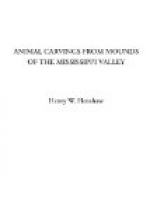Some of these sculptures have a value, so far as ethnological research is concerned, much higher than they can claim as mere works of art. This value is derived from the fact that they faithfully represent animals and birds peculiar to other latitudes, thus establishing a migration, a very extensive intercommunication or a contemporaneous existence of the same race over a vast extent of country.
The idea thus suggested fell on fruitful ground, and each succeeding writer who has attempted to show that the Mound-Builders were of a race different from the North American Indian, or had other than an autochthonous origin, has not failed to lay especial stress upon the presence in the mounds of sculptures of the manatee, as well as of other strange beasts and birds, carved evidently by the same hands that portrayed many of our native fauna.
Except that the theories based upon the sculptures have by recent writers been annunciated more positively and given a wider range, they have been left almost precisely as set forth by the authors of the “Ancient Monuments,” while absolutely nothing appears to have been brought to light since their time in the way of additional sculptured evidence of the same character. It is indeed a little curious to note the perfect unanimity with which most writers fall back upon the above authors as at once the source of the data they adduce in support of the several theories, and as their final, nay, their only, authority. Now and then one will be found to dissent from some particular bit of evidence as announced by Squier and Davis, or to give a somewhat different turn to the conclusions derivable from the testimony offered by them. But in the main the theories first announced by the authors of “Ancient Monuments,” as the result of their study of the mound sculptures, are those that pass current to-day. Particular attention may be called to the deep and lasting impression made by the statements of these authors as to the great beauty and high standard of excellence exhibited by the mound sculptures. Since their time writers appear to be well satisfied to express their own admiration in the terms made use of by Squier and Davis. One might, indeed, almost suppose that recent writers have not dared to trust to the evidence afforded by the original carvings or their fac-similes, but have preferred to take the word of the authors of the “Ancient Monuments” for beauties which were perhaps hidden from their own eyes.
Following the lead of the authors of the “Ancient Monuments,” also, with respect to theories of origin, these carvings of supposed foreign animals are offered as affording incontestible evidence that the Mound-Builders must have migrated from or have had intercourse, direct or indirect, with the regions known to harbor these animals. Were it not, indeed, for the evident artistic similarity between these carvings of supposed foreign animals and those of common domestic




